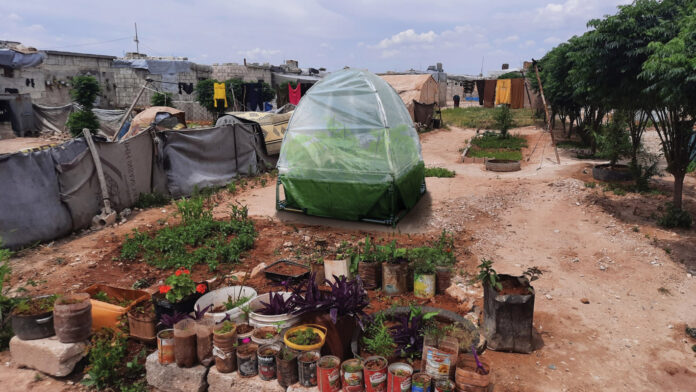Enabling self-sufficiency in the face of adversity can be a powerful driver of change. Kindred Crop is an innovative agricultural toolkit that aims to empower refugees by providing the resources and knowledge to cultivate their own food in challenging environments.
Refugees often endure harsh conditions, relying on minimal rations in inhospitable environments. This initiative project seeks to address these challenges by introducing a flexible, sustainable solution for growing food in arid regions. The project aims not only to improve food security, but also to restore a sense of agency and dignity to displaced individuals.
The life of refugees is often characterized by a lack of basic necessities, including nutritious food, water, and shelter. These individuals are forced to leave their homes due to conflict, persecution, or natural disasters, finding themselves in refugee camps where resources are scarce – where they often have to stay for many months if not years. Traditional aid efforts, while crucial, often focus on short-term relief rather than longer-term sustainability.
The primary focus of Kindred Crop is to assist refugees living in camps, particularly in arid regions such as the Middle East and sub-Saharan Africa, where water is a valuable resource that cannot be wasted. The kit enables the construction of a compact and efficient farming system that reduces water consumption using a unique irrigation and water recapture setup, while protecting plants from harsh climates. The custom components used for these systems are 3D printed from a renewable bioplastic, while the majority of the system itself is constructed using available materials.
One of the standout features of Kindred Crop is its innovative use of materials. Mature refugee camps often see the replacement of tents with prefabricated shelters, leaving behind tent poles and waterproof tent fabric as common materials. Kindred Crop leverages these readily available resources for the frame and lining of the system, along with conventional plastic bottles for the reservoirs of the irrigation system. The 3D-printed components were designed specifically to be adaptable to any material and diameter of tent poles that could be found, and other scrap such as planks or even rebar. This approach not only minimises the environmental impact of the project, but also maximizes the utility of available resources, upcycling scrap into something much more valuable.
In developing the Kindred Crop initiative, I was enabled by the Product Design staff at NCAD, Dublin, and supported by CARE (Cooperative for Assistance and Relief Everywhere) International, an NGO with significant experience in the Middle East, as well as experts from the International Center for Agricultural Research in Dry Areas (ICARDA).
CARE gave detailed insights into the conditions in the camps that they run, and ICARDA’s involvement was crucial for validating the Kindred Crop concept: a test model was built in Lebanon to assess the system’s effectiveness in a truly arid climate. The collaborative efforts of these organisations ensured that the kit was not only theoretically sound, but also practically effective in harsh conditions, and would adequately contribute to addressing the issue of food insecurity in refugee camps.
During the research phase, scaled-down test systems were used to ensure the effectiveness of the designed irrigation, drainage, and greenhouse systems. These yielded spinach, lettuce, and chard in six weeks, with courgettes and mangetout being ready to harvest shortly thereafter as well. These crops were chosen to align with the climate and cuisine in Lebanon and Syria, where
the system will be tested in the coming months. The successful growth of these crops demonstrated the viability of the Kindred Crop system, proving that it could indeed provide a sustainable source of nutritional food in arid environments.
CULTIVATING AGENCY
Kindred Crop is more than a farming kit; it is a catalyst for empowerment. The ability to cultivate a nutritious diet directly impacts physical health and well-being, while the act of farming instills a sense of purpose and accomplishment. By addressing food security through sustainable agriculture, the initiative empowers individuals to take control of their nutrition and well-being. This project underscores the potential for self-sufficiency and resilience in the face of adversity, providing a model for similar interventions in other challenging environments.
The psychological benefits of Kindred Crop are potentially significant. For many refugees, the loss of their homes and livelihoods leads to a profound sense of disempowerment and dependency. By giving refugees access to the tools and knowledge necessary to grow their own food, Kindred Crop helps to restore a sense of control and autonomy. Farming becomes a therapeutic activity, fostering a connection to the land and a sense of normalcy amidst the upheaval of displacement. This sense of purpose and accomplishment can have far-reaching effects on mental health and community cohesion.
Moreover, the introduction of Kindred Crop into refugee camps can stimulate local economies and foster a spirit of cooperation. As refugees begin to grow their own food, surplus produce can be traded or sold within the camp, creating micro-economies and reducing exclusive dependency on external aid. The skills learned through using the Kindred Crop kit are transferable, providing refugees with agricultural knowledge that can be valuable even after they leave the camps.
The sustainability of such a project is a crucial aspect. The use of renewable bioplastic and recycled materials not only reduces environmental impact but also aligns with global efforts to promote sustainable development. By giving refugees the opportunity to engage in, learn, and test sustainable farming practices, the initiative encourages a harmonious relationship with the environment, even in regions where resources are scarce.
The kit can be useful for local backyard or balcony gardeners, too. For the benefit of all groups, the design is open source, and can be reproduced by anyone who has access to a hardware shop and a 3D-printer (or 3D-printing service). ✽
 LIAM HAYES is a product designer interested in sustainable solutions for people and the environment. Portfolio: liamhayes.myportfolio.com. Contact: liam.hayes.eu@gmail.com
LIAM HAYES is a product designer interested in sustainable solutions for people and the environment. Portfolio: liamhayes.myportfolio.com. Contact: liam.hayes.eu@gmail.com




